Hello, I'm new to this site and know very little about swords. I seek advice about some swords and other military weapons that I retrieved from my parent's attic that have been there for decades.
Let me back up, my father, back in the 1930s went to a junk yard in New Orleans and purchased a number of swords, long rifles, bayonets and knives for a few quarters. He cleaned them up and displayed some and put most in the attic.
Katrina struck 3 years ago and my father lost his home -- but all things in the attic were saved as the water only got to 12 feet where he lived. I flew in from out of the country, broke the military barricade (thanks to my well politically situated friend) and got to as many things as I could before the looting started.
My parents had evacuated and moved into a rental not far from their house and are safe and sound. My father divided the artifacts between my brother and myself and now I am finally finding the time to pursue the history of these items.
1. a handmade rapier with the word "KNECHT" stamped at the base of the blade.
2. A straight '1918' sword, This sword is marked at the blade, "LF & C, 1918." There is a little 'flaming bomb' between the "F" and the ampersand. The other side of the blade has a "US" and a "No. 12" on it with a undiscernable mark on it that looks like a "W" or a tree. The blade was broken at the end.
3. A French bayonet, My father tells me this is a French bayonet, probaby from the Franco Prussian War. Its blade is three sided and has no discernable markings on it.
4. A German Sawtooth Knife, The only marking found on the scabbord is a stamp near the mouth that is of what looks like a sideview of a cat with his tail up within a circle. The only marking found on the sawtooth blade was on the side of the blade, something which looked like an Old English "D" with a small crown above it. This is a piece from WW I as I understand it. The leather sheath holder seems to be disintergrating at the cleat where it attached to the sheath.
5. A straight blade saber, 1845, Saber, marked at the base of the blade on one side, "NP Ames, 1845." On the other side there is stamped at the base of the blade, " US, JH." The blade was broken at the end and sharpened to a point.
6. Two Calvary Swords, probably Union, 1860s, marked on face of the hilt of one is "25" and marked on the hilt of the other is "36."
I have a few photos but I can't seem to place so many photos on this post. Should you like to see what they look like, please email me. (Or if someone can explain how to put them on this post, I'd appreciate it.)
Any help you can give me is appreciated as I am most interested in what these swords are. Thank you for your help!
Jon Russo
Glen Ridge, NJ
#2 is a M1913 "Patton" Cavalry Saber, made by Landers, Frary and Clark in 1918. The "No.12" is the inspector's mark, and the "W" is an eagle head.
#5 sounds like perhaps a M1840 Cavalry Saber, except for the straight blade.
Pics would help immensely.
#5 sounds like perhaps a M1840 Cavalry Saber, except for the straight blade.
Pics would help immensely.
I was given help to be able to put the photos on the forum. Any help you can give me is appreciated. THANkS!
 Attachment: 99.88 KB
Attachment: 99.88 KB
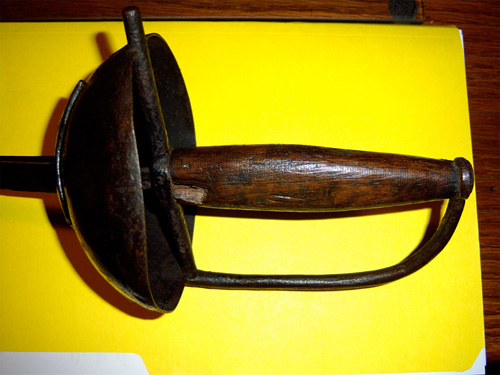
1. a handmade rapier with the word "KNECHT" stamped at the base of the blade.
 Attachment: 120.53 KB
Attachment: 120.53 KB
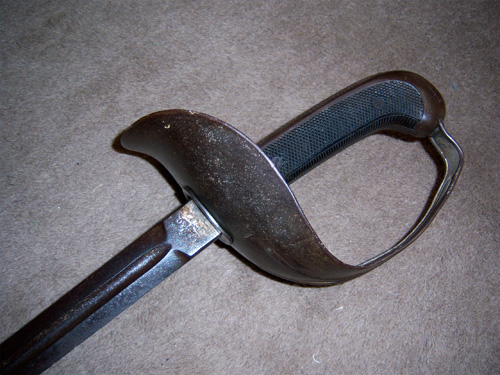
2. A straight '1918' sword, This sword is marked at the blade, "LF & C, 1918." There is a little 'flaming bomb' between the "F" and the ampersand. The other side of the blade has a "US" and a "No. 12" on it with a undiscernable mark on it that looks like
 Attachment: 132.81 KB
Attachment: 132.81 KB
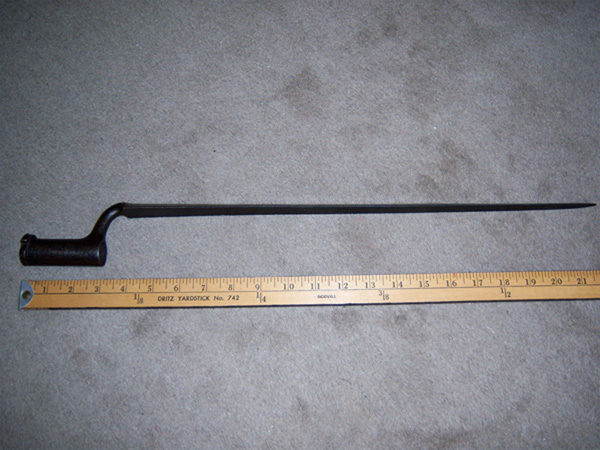
3. A French bayonet, My father tells me this is a French bayonet, probaby from the Franco Prussian War. Its blade is three sided and has no discernable markings on it.
 Attachment: 128.95 KB
Attachment: 128.95 KB
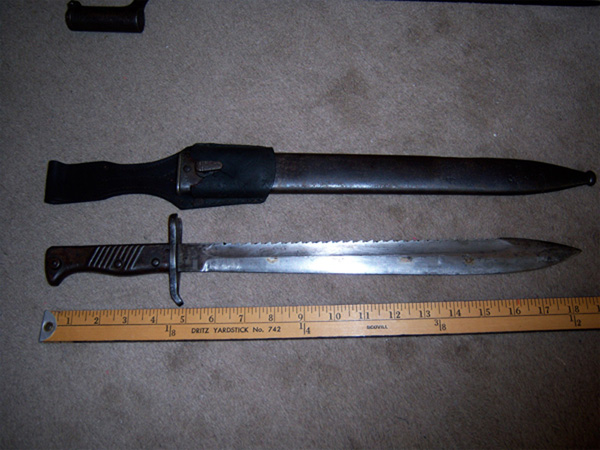
The Sawtooth knife, believed to be WW I German. A German Sawtooth Knife, The only marking found on the scabbord is a stamp near the mouth that is of what looks like a sideview of a cat with his tail up within a circle. The only marking found on the sawtoo
 Attachment: 120.05 KB
Attachment: 120.05 KB
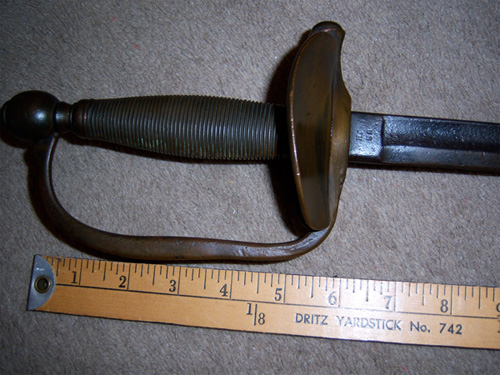
A straight blade saber, 1845, Saber, marked at the base of the blade on one side, "NP Ames, 1845." On the other side there is stamped at the base of the blade, " US, JH." The blade was broken at the end and sharpened to a point.

1. a handmade rapier with the word "KNECHT" stamped at the base of the blade.

2. A straight '1918' sword, This sword is marked at the blade, "LF & C, 1918." There is a little 'flaming bomb' between the "F" and the ampersand. The other side of the blade has a "US" and a "No. 12" on it with a undiscernable mark on it that looks like

3. A French bayonet, My father tells me this is a French bayonet, probaby from the Franco Prussian War. Its blade is three sided and has no discernable markings on it.

The Sawtooth knife, believed to be WW I German. A German Sawtooth Knife, The only marking found on the scabbord is a stamp near the mouth that is of what looks like a sideview of a cat with his tail up within a circle. The only marking found on the sawtoo

A straight blade saber, 1845, Saber, marked at the base of the blade on one side, "NP Ames, 1845." On the other side there is stamped at the base of the blade, " US, JH." The blade was broken at the end and sharpened to a point.
The sawtoothed bayonet is for the Mauser Gwehr 93 and was intitially issued to pioneers. It gained some popularity with the higherups for issuing to regular line troops, because of the intimidating nature of its appearence on the end of a rifle, but the saw teeth were ment for cutting brush and not for disemboweling Englishmen and Frenchmen. They are somewhat rare.
The cuphilt sword, and this is very superficial, based only on the photo, a real hand on inspection is really necessary, alot more pics of it would help, may be one of a type know sometimes as Caribbean cuphilts, refering to a heavy bladed ( usually but not always with imported blades) cuphilted swords made here in the Americas in the later 17th and 18th centuries. We tend to associate the type with piratical activities but they were used asea and on land. Again more pics of this one would be better to help give a more positive ID.
The cuphilt sword, and this is very superficial, based only on the photo, a real hand on inspection is really necessary, alot more pics of it would help, may be one of a type know sometimes as Caribbean cuphilts, refering to a heavy bladed ( usually but not always with imported blades) cuphilted swords made here in the Americas in the later 17th and 18th centuries. We tend to associate the type with piratical activities but they were used asea and on land. Again more pics of this one would be better to help give a more positive ID.
I've attached more photos of the CUPHILT SWORD. It was surmised that this might have been a weapon used in the Caribbean as it was found in a junk yard in New Orleans in the 1930s. This sounds like a reasonable possibility.
If anyone would like to see more photos of any of these swords, I'm glad to do so. Any information you can pass on to me is much appreciated.
 Attachment: 24.18 KB
Attachment: 24.18 KB

 Attachment: 43.86 KB
Attachment: 43.86 KB
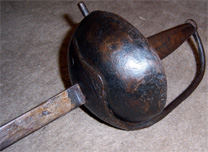
 Attachment: 103.35 KB
Attachment: 103.35 KB
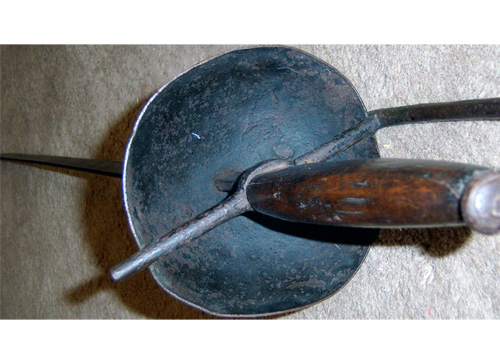
If anyone would like to see more photos of any of these swords, I'm glad to do so. Any information you can pass on to me is much appreciated.



Jup thats indeed a WW1 German Bayonett.
The sawtooth - as pointed out were meant as a working tool either for gathering fire wood or to saw though wooden poles holding the shap pointy wires in place at the enemy lines.
As far as i recall propaganda claimed it was used to create "more vicious" wounds, but that was not true. However the campaign was so successfull that the order was given to grind the teeth away. Thats why its so rare today, as most of those that once had teeth and were in service of the time were ground down.
Read those on multiple pages in the past when i looked to find out more over my WW2 bayonett, so i am pretty sure it has some merit to it.
Best regards
Klaus
The sawtooth - as pointed out were meant as a working tool either for gathering fire wood or to saw though wooden poles holding the shap pointy wires in place at the enemy lines.
As far as i recall propaganda claimed it was used to create "more vicious" wounds, but that was not true. However the campaign was so successfull that the order was given to grind the teeth away. Thats why its so rare today, as most of those that once had teeth and were in service of the time were ground down.
Read those on multiple pages in the past when i looked to find out more over my WW2 bayonett, so i am pretty sure it has some merit to it.
Best regards
Klaus
I've attached some close up photos of the cuphilt sword. If anyone can give me an idea of how old, where it was made, worth, I'd be most appreciative. Look closely at one photo and the word "KNECHT" can be found at the base of the blade.
Thanks!
Jon
 Attachment: 76.14 KB
Attachment: 76.14 KB
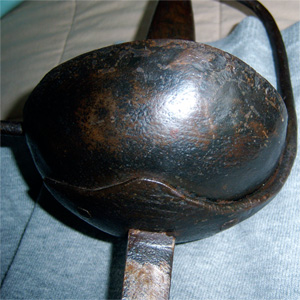
Look close at the irregularly shaped rivets. This is handmade. But what year?
 Attachment: 58.6 KB
Attachment: 58.6 KB
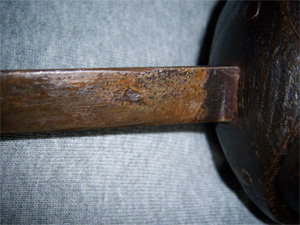
Here is a close up of the blade near the cuphilt.
 Attachment: 140.25 KB
Attachment: 140.25 KB
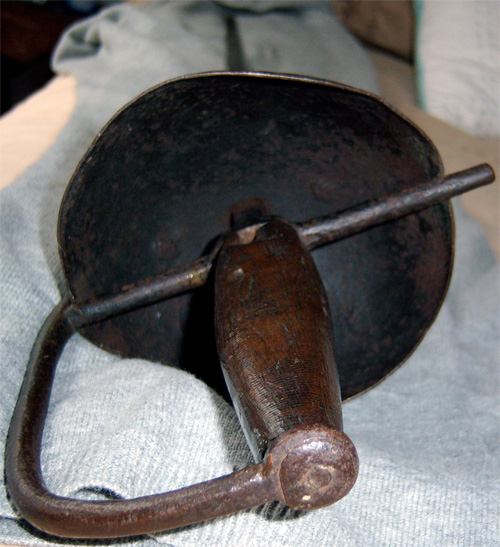
Here is a close up of the pommel
 Attachment: 75.27 KB
Attachment: 75.27 KB
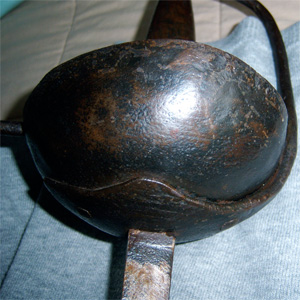
here's a look at the cuphilt
 Attachment: 107.63 KB
Attachment: 107.63 KB
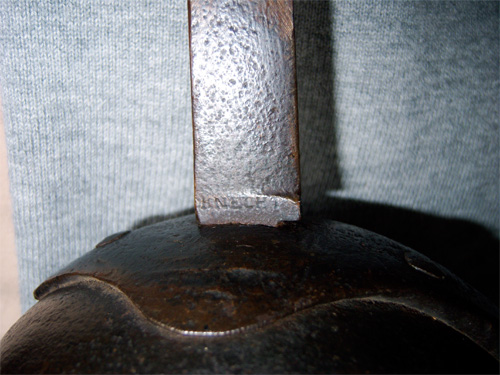
The word "KNECHT" can be seen at the base of the blade.
 Attachment: 118.24 KB
Attachment: 118.24 KB

close up where the blade meets the cup.
 Attachment: 137.88 KB
Attachment: 137.88 KB
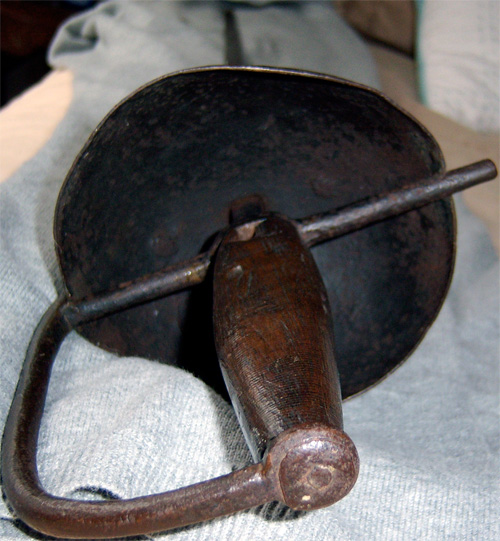
a look inside the cup of sword
 Attachment: 108.98 KB
Attachment: 108.98 KB
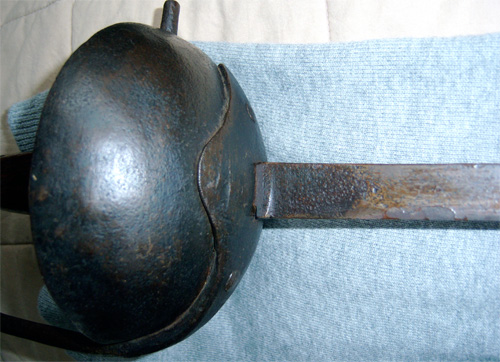
The cup and the blade.
Thanks!
Jon

Look close at the irregularly shaped rivets. This is handmade. But what year?

Here is a close up of the blade near the cuphilt.

Here is a close up of the pommel

here's a look at the cuphilt

The word "KNECHT" can be seen at the base of the blade.

close up where the blade meets the cup.

a look inside the cup of sword

The cup and the blade.
| Jon Russo wrote: |
| I've attached some close up photos of the cuphilt sword. If anyone can give me an idea of how old, where it was made, worth, I'd be most appreciative. Look closely at one photo and the word "KNECHT" can be found at the base of the blade.
Thanks! Jon |
Hi Jon, I've been combing the interweb for references to "knecht" on sword blades. This is what I've turned up so far.
There are a number of military swords stamped 'Knecht' and 'Solingen' or "made in Solingen". This would seem to indicate German manufacture.
However, in The American Sword 1775-1945 I discovered there was a 19th century New Orleans based maker, Pierre Lamothe, who stamped his blades with "Pierre Guillaume Knecht", "Knecht" or "P Lamothe" . Not only that but on at least some of his swords he stamped: "Pierre Guillaume Knecht fabriquant à Solinge" This would seem to tie the two finds together.
I will continue my search.
EDIT: Could you show us a picture or describe the edge/tip of the blade? This would let us know if it was designed for combat or as a stage sword.
EDITEDIT: It seems Pierre Lamothe was also a fairly good maker of silverware and other cutlery, or at least some of his work is in the Louisiana State Museum.
The blade from the look of the forte seems to be single edged. The rough but servicable style of maufacture still strongly reminds me of other colonial made blades i've seen and owned. The tang seems to be piened which removes the likelyhood of a theatrical piece in large part for me as every theatrical piece i've ever seen was screwed together. Its to rough for the Victorian copy market, the Victorians were after slick and polished pretty much, they wanted repros that looked like higher end originals. I'm thinking this is a colonial made sword for local service, could have been made in South America, the Carribean or North America but based on the pics and the hands on time i've had with some of rougher adhoc colonial made swords it feels that way to me.
Based on the pic, #5 looks to be a M1840 NCO Sword.
Here is a photo of the tip of the sword...
 Attachment: 55.24 KB
Attachment: 55.24 KB


Hello,
I have heard of a Knecht family of blade makers in Germany (at Solingen if memories serve me right), Their mark was a viola (some kind of violin), but usually it was stamped on the tang. I suppose don't want to disassemble the sword to look at the tang. :\
Happy new year, DL[/i]
I have heard of a Knecht family of blade makers in Germany (at Solingen if memories serve me right), Their mark was a viola (some kind of violin), but usually it was stamped on the tang. I suppose don't want to disassemble the sword to look at the tang. :\
Happy new year, DL[/i]
I don't know where I read this...
But somewhere I read that during WWII veteran German soldiers would often take saw-toothed bayonets from new soldiers who were joining their units. Supposedly, they were afraid that American troops would harm prisoners who were captured with saw-tooth bayonets so they took them away from the new guys to protect them.
But somewhere I read that during WWII veteran German soldiers would often take saw-toothed bayonets from new soldiers who were joining their units. Supposedly, they were afraid that American troops would harm prisoners who were captured with saw-tooth bayonets so they took them away from the new guys to protect them.
Page 1 of 1
You cannot post new topics in this forumYou cannot reply to topics in this forum
You cannot edit your posts in this forum
You cannot delete your posts in this forum
You cannot vote in polls in this forum
You cannot attach files in this forum
You can download files in this forum
All contents © Copyright 2003-2006 myArmoury.com — All rights reserved
Discussion forums powered by phpBB © The phpBB Group
Switch to the Full-featured Version of the forum
Discussion forums powered by phpBB © The phpBB Group
Switch to the Full-featured Version of the forum